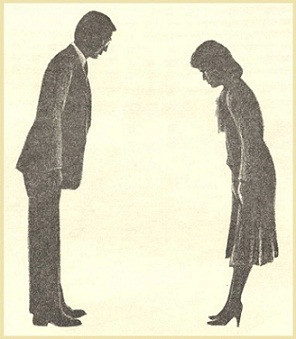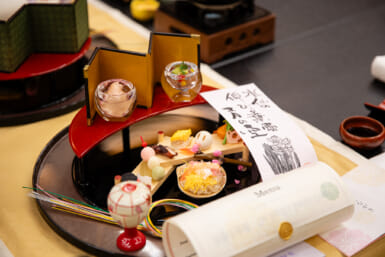Most polite people… or world’s rudest?
by Jack Seward
AFTER A FEW DAYS OR WEEKS IN JAPAN, most foreign visitors leave content in the conviction they have witnessed the world’s most polite people in action: smiling, neatly dressed elevator girls who bow hundreds of times daily; waitresses who kneel to take a guest’s order; first-time acquaintances who seem quite prepared, even eager, to sacrifice anything short of family honor to ensure the visitor’s comfort and tranquility of mind.
But then there is the other side of the coin. Ask the opinion of a long-time former resident of Japan, someone who has really lived among the Japanese, and don’t be surprised if he tells you that, in his carefully considered opinion, the Japanese may well be the world’s rudest people.
Why this appalling dichotomy? How can such extreme differences of opinion exist, both being defended and clung to tenaciously by sizable groups of sober, serious citizens?
Part of the answer lies in definitions: To Westerners, kindness and sincere concern for the welfare of others—including, importantly, persons with whom we have no particular relationship — are integral parts of politeness. A man gives his scat on a bus to an old woman whom he has never seen because he wants her to be comfortable.
But few Japanese would feel that way about it. Giving one’s seat on a bus to a complete stranger — male or female, young or old — is not a matter of pressing concern to them- Such a person stands too far apart from their area of living.
The Japanese concept of etiquette is, first and above all, a matter of demarcation. Lines — many lines — have to be drawn. Persons on this side of the line are in; those on the other are out. Westerners would say that courtesy — if it is to be genuine — must be extended to a the Japanese would protest that in their crowded islands it is simply not possible to be really courteous to so many.
To them, courtesy is not in limitless supply. Only by withholding it from strangers can they thus offer it lavishly to acquaintances, that is, those on the right side of the lines mentioned above. If given to friend and stranger alike, the worth of the gift is diluted. And then where, they ask, is the value of being a friend?
The distance between private manners and public behavior in Japan is appallingly wide. This lack of consideration for strangers—of public morality, if you will—can be seen in most situations where there is little danger of specific personal identification being made, to one’s later detriment. When Russian writer Ilya Ehrenburg visited Japan, he wrote at length about his observations of the people. The Mainichi newspaper quoted Ehrenburg as saying: “The impoliteness of the Japanese, which was sometimes ruder than the rudest manners of Europeans, surprised me greatly.”
A recent writer has commented more calmly: “Unfortunately, Japanese manners seem to be peculiar to personal relations, and they incline to die a sudden death in the ruder atmosphere of public life.”
What do Japanese themselves say about this facet of their national character? Consider this commentary that appeared in the Konnichi no Mondai (Problems of Today) column of the Asahi newspaper:
“Though we Japanese are said to be a polite and amiable people among foreigners, we tend to be polite and amiable only to those whom we know or respect. Why are we like this? Because we are lacking in the spirit of mutually helping persons living in the same society, whether we know them or not… Our community spirit often exists only within the family or among friends and relatives and extends at best to co-workers, members of the same organization or group, or persons to whom we have been properly introduced.”
Another facet of the same syndrome of public behavior patterns is the typical Japanese failure to help anyone who is injured or taken suddenly ill on the streets or in any kind of danger. The desire in this instance is to avoid the establishment of a relationship and its concomitant responsibilities. While most Westerners believe that the more friends they have, the better off they are, the Japanese tend to shy away from additional acquaintances, feeling that each is more of a burden than a pleasure or source of gain. Each requires much attention, and one can do only so much.
Further, the social values involved are so delicate, so subject to varied interpretations and evaluations that the associations governed by them require the taut concentration of a tightrope walker. To maintain each of several social relationships in proper balance and in a state of good repair is not, as the Japanese would say, an “asameshi-mae no shigoto” — an easy, “before breakfast” job. They require much deliberation, concentration, time, worry and expense. Although there may be pleasant moments, these are incidental. The Japanese regard the proper servicing of a social connection as a duty, and their attitude toward duty is manifest in the Imperial Rescript to Soldiers and Sailors: “Be resolved that duty is heavier than a mountain, while death is lighter than a feather.”
Before taking up recommendations for a realistic code of behavior for foreign visitors, we might first regard some of the stranger aspects of Japanese etiquette and explain their raison d’etre.
After an initial acquaintance with the ritualistic politeness of the Japanese, the foreign visitor may be shocked when he enters a store to make a purchase and finds himself coldly ignored. He may wonder what, short of leprosy, could have brought on this dramatic about-face, but he need not think that he alone has been selected for this disdainful treatment. It happens to most of us, and in many places. Mostly this apparent indifference should be contributed lo inability in English and uneasiness in the presence of a foreigner, whose eccentric ways are legend.
Beginning in about the 6th century, the Japanese began to emphasize “behaving in an expected manner,” following rigidly prescribed rules of conduct in which morality as we know it in the West, basing our actions and words on certain abstract principles, was merely incidental.
Whereas we devoted ourselves to substance without much heed to form, the Japanese concerned themselves with substance within a form, which consisted of performing a great many acts, large and small, in a precisely specified manner: how to sit, how to eat, how to open doors, how to wrap gifts, how to arrange bedding so that its head always pointed in a certain direction, etc.
The slightest variation was not merely frowned on. In serious cases, it was classified as a crime. This led to the development of what Inazo Nitobe characterized as “coercive etiquette.”
About what Nitobe so described, Kakuzo Okakura once wrote. “Our etiquette begins with learning how to fold a fan and ends with the rites for committing suicide.” With volumes in between.
In Japan manners and form came to be sanctified as saiko no bitoku or ultimate virtues, and even today students are still taught that these are more important than accomplishmens or original ideas.
It has been difficult for us to grasp just how important form can be in Japan, but I am reminded of one historical incident that may suggest it.
During the troubles of the mid-’30s in Japan, a small group of hot-blooded young Army officers conspired to assassinate a prominent bureaucrat who opposed their ultra-nationalistic aims. Using a pretext, they convinced the bureaucrat’s wife they had to see her husband on urgent business, whereupon she conducted them to his room in the rear of their home, then retired. The young officers gave the bureaucrat his choice between death by their swords or self-inflicted death, so he opted for the latter. When the wife came to serve the guests tea, she saw her disemboweled dying husband and cried out in anguish. As the officers were leaving, a lieutenant among them bowed to the wife and said, “Excuse us for the annoyance we have caused.” (Domo go-mendo wo kakemashita.)
Having just killed her husband, they apologized for the “annoyance.” Such attention to form while ignoring substance would not strike many Japanese as incongruous, even today.
Certainly the most apparent manifestation of manners in Japan is the bow, which is practiced as a sign of mutually acknowledged inequality between persons of different social status. The deeper the bow, the more polite it becomes. It is used not only when greeting an acquaintance and when taking leave of him but also when expressing thanks or an apology and when making a request.
These days older Japanese are often heard to remark that the younger generation is no longer well-mannered because they don’t bow as often as they once did. Before the war it seemed that elementary school children did little else but bow. In the morning they bowed to their parents and to altars and shrines in the home. They bowed before temples and shrines on the way to school, where they bowed to the building housing the Imperial Photograph. There were schools where they even bowed every time they opened and closed their textbooks, to which they were thus paying respect as depositories of knowledge. When they assembled in the playground for exercises, they bowed in the direction of the Imperial Palace as well as when the Rising Sun flag was raised and when the Imperial Rescript on Education and other edicts from the Emperor were read.
Because of post-war efforts to reduce such formality, however, major changes have taken place, so that such lower-grade pupils, with four learning sessions a day now, will bow to the teacher at the beginning and end of each class, for an average of a mere eight times a day.
The weekly magazine Gendai has studied how often such Japanese bow after they grow up. For instance, a 32-year-old employee of the Business Section of a large manufacturer made a count at the behest of the magazine and found he had bowed 123 times on that day. Priests at the Honganji Temple in Tsukiji, Tokyo, said that they bowed on the average 150 times a day. A conductor on a commuter train of 13 coaches bows each time he checks a ticket, for a daily average of 2,132 times. And even this record was surpassed by the elevator girls in a certain Ginza department store who estimated they bent from the waist to everyone boarding and leaving the elevator for a winning total of 2,560 times a day.
So important is the institution of the bow that the Kintetsu Department Store in Osaka, together with many other stores and even corporations, have bought machines that teach their employees just how to bow.
The employee steps up on this device, which somewhat resembles a scale for measuring weight, and places his or her chest against the breast plate. The machine then forces the body to adjust to the proper greeting position: a bow of 15 degrees for passing persons in the hall, of 30 degrees for welcoming customers or guests, and of 45 degrees for persons departing the premises.
The Gendai went further and found that women bow 35 percent more frequently than men and, on roads and neighborhood streets, acquaintances begin to bow when they come within 20 meters of each other.
The time consumed by women in bowing is usually 1.4 seconds while men are faster with only 0.9 seconds.
If the foreign visitor is inclined to abide by local customs to the extent of bowing at least now and then, his problems are when…and to whom…and to what degree. These rules are understandably quite complicated and not designed for easy mastery. Furthermore, the foreigner may learn a few basic rules and attempt to bow accordingly, only to find that some Japanese, believing him to be a visitor wholly unacquainted with such niceties, do not bow to him at all.
The best course, I believe, is to always wait to see what the other party does: if he extends his hand, take it; if he bows, return the courtesy, but only to the extent of about 15 degrees.
For those who want to be as thoroughly Japanese as possible, however, the body is bent from the waist with the hands held flat, fingers stiffly extended, against the outside of the thighs. When seated on tatami, the bow should begin from a kneeling position with the hands placed flat on the tatami in front of the knees, the arms forming an outward curve, and the fingers of both hands pointing slightly inward. From this position one should bend forward to within a few inches of the back of the hands or the tatami.
Conventional wisdom has it that outsiders, whether they be foreigners or fellow countrymen, do not get invited often to Japanese homes since the host and hostess would feel they could not offer their guest the respect, in the form of comfort and fine comestibles, that could be obtained in public establishments of good quality. Certainly this is true in as far as it goes, but I suspect the same host and hostess might also feel that such an occasion would offer them no opportunity for pleasant relaxation, so tensely preoccupied would they be with having such a guest under their own roof, so they would prefer to invite their guests to restaurants away from home.
Granted that home visits may be rare, the foreign visitor, if he persists, may eventually receive such an invitation, so he should consider a few words of advice that will enable him to avoid the more gauche and glaring improprieties.
1. Doors in Japan are not made to be knocked on. To do so is a violation of proper manners. If there is no bell, the caller should slide open the front door, step into the entrance-way, and call out “Gomen kudasai.”
2. As a guest staying in a Japanese home, you will be asked to bathe first. Sit on the wooden stool outside the bath and soap yourself, then use the small bucket to ladle water and wash off the soap. Only after that should you enter the bath itself, the water of which should be left as clean as possible since others will be entering it.
3. Take care not to show your back to your host or hostess while removing your shoes, which should then be placed neatly side by side, with the toes pointing bad toward the entrance.
4. Never ask to or expect to be given a look into the kitchen.
5. When escorted to the tatami rooms for guests you will be asked to sit with your back to the tokonoma, which is the position of honor. (The humblest position is the one nearest the door.) A zabuton or cushion will be provided for you to sit on. If there is a hanging scroll or floral arrangement in the tokonoma, it is proper to express your admiration of it. You will be offered tea or, in some homes, coffee, and it is proper to accept a second cup.
6. Wait until you have stepped out of the entrance way and are outside the house before donning your hat, overcoat and gloves.
7. When the situation is reversed and the Japanese come to your home as guests, you would be wise to avoid the use of the American time-honored formula: “Please make yourself at home.” The Japanese may interpret these words to mean something like, “I’m not going to pay much attention to your needs or wants while you’re in my home, so you’d best shift for yourself.”
8. If you are working in Japan and want to strictly abide by Japanese custom, you should not consider inviting your superiors or co-workers of equal rank to your home, with the possible exception of the occasion of a housewarming party. You may. however, extend such an invitation to your subordinates from time to time.
9. If you are asked to a Japanese home, you should take a gift with you. No matter what your income, a comparatively modest gift is recommended, especially if the host and hostess are of only moderate means. They will want someday to reciprocate on a compatible scale, so very expensive gifts will only cause them consternation.
It is not unlikely that the world of food provides the setting for most contacts between foreign visitors and the Japanese, whether in private homes or public restaurants, so the rules of conduct operative in these areas deserve some separate comments. A god’s plenty of Do’s and Don’t’s surround eating in Japan. To list them all would be beyond the scope of this article, even if I knew them, which I do not. Besides, the Japanese are quite tolerant of foreigners, especially visiting foreigners, and are usually ready to overlook missteps and fumbles.
But as one stays longer in Japan and immerses himself more deeply in the culture, his curiosity, if nothing else, may prompt him to want to become more familiar with the rules and other germane words of advice. While far from complete, the following should serve as a start for those so inclined.
1. You should use both hands to hand your rice-bowl to whomever is serving you and take it back with both hands, with a slight bow of the head, when it is returned to you full.
2. Respect the food you are served by leaving no dish untouched. Make admiring comments on both the taste and the appearance of the food.
3. Unless truly desperate, do not fill your own glass. Wait until someone notices your empty glass or cup, then raise it for ease of pouring.
4. Return the compliment by filling the cup of the person who has just filled yours. The correct form here is to fill the cup from the drinker’s left.
5. If you are having a meal in the home of a Japanese friend, he or his wife will probably start the meal by saying “Nani mo gozaimasen ga takusan meshiagatte kudasai” which means ‘There is nothing to eat, but take plenty.” Ignore the apparent contradiction and say “Itadakimasu” meaning “I’ll have some.”
6. Your chopsticks should not be set down so that they point at anyone across the table nor should they ever be left half-standing inside a bowl.
7. Despite the number of young people you may see standing outside McDonald’s fast-food stands eating hamburgers, it is still not good manners to eat on the streets or in buses or subways, although such is not the case on long-distance trains.
8. Pay bills and give tips as unobtrusively as possible. Unless you have really strong reason to suspect that you may have been cheated, do not linger over a painstaking examination of a bill. Too much attention to financial specifics is embarrassing to the Japanese and can turn them against you. No matter who is the most, you should avoid discussion with your Japanese friends of how much the dinner or the drinks cost. You will see that often Japanese businessmen will leave their favorite bar after an evening of compotation and not only will not pay the bill on the spot but often will not even sec the bill. They assiduously seek to avoid such financial moments of truth, particularly in the presence of guests.
9. Tipping in Japan is not the prevalent custom it is in many Western nations because providing good service without making additional charges for it seems to be ingrained in the national character. There are, however, exceptions. Many eating and drinking establishments add a 15 percent service charge to the bill. In places where no service charge is added, you should consider tipping the waiter only if the restaurant is of the high-class category. You should give a tip to your room-maid in ryokan or Japanese inns, preferably at the beginning of your stay, as well as to tour guides, drivers of rented cars (haiya), and baggage porters in
train stations and airports, but not to bellboys in hotels or to taxi drivers, unless they perform some outstanding service on your behalf.
10. Generally speaking, one does not need to pay for each drink separately in Japanese bars.
11. When you finish your meal, whether in a home or restaurant, say to your host, “Gochiso-sama deshita,” or, if you don’t want to hazard this in Japanese, say simply, in your language, “Thank you very much for the excellent meal.”
12. Perhaps most important is this caution: Never, never examine each dish set before you with faintly suspicious eyes and then tediously persist in asking the host or waitress exactly what it consists of. You may, of course, just be inquiring so you can later duplicate the same culinary masterpiece in your own kitchen, but most visitors ask because they fear someone is trying to slip a piece of raw fish or some chopped caterpillar entrails into their victuals. The Japanese are aware of this reason and understandably are not flattered by it.
13. Again, if the situation is reversed and you are acting as host to a Japanese who has dropped by to see you, do not pay much heed when he declines your offer of something to eat or drink the first time. Press him a second and even third time or perhaps just go ahead and serve him a snack or drink anyway.
So much for manners surrounding food and drink. Let us now examine what one should and should not do and say in other situations.
1. Whenever you take photos of Japanese acquaintances, you should send them copies. Also, bear in mind that older Japanese do not like to have pictures taken in groups of three.
2. Dress in good taste, on the conservative side. Japan may be vacation land to you, but it is where the Japanese live and work. Shorts should never be worn, except in such recreation spots as beaches and golf courses. Let good sense dictate your attire.
3. It is best not to bargain.
4. Generally speaking, traditional Japanese etiquette opposes the asking of a direct question: “How many children do you have?” “Where were you born?” “What is your religion?” “How do you feel about the present regime in France?” Rather, you should create the conversational atmosphere that will afford a person an opportunity to volunteer such information. The difficulty arising here, however, is that more than a few Japanese have heard of and perhaps witnessed our predilection for direct interrogation and so feel justified in giving us a taste of the same. Thus, although you may have clamped a lid on your own curiosity out of respect for your host country, you will now and then meet a Japanese who will ask you questions so blunt that they border on the rude and even vulgar: “How much money do you make?” “How often do you bathe?” “Do you have a mistress?” “Only one?” While there are such Japanese, bear in mind that they are, to other Japanese as well, the unwelcome variants and not the welcome norms.
5. Even though it’s a bother to have them made, you really should carry meishi, or calling cards, with you in Japan, and these should give not only your name, address and telephone number, but also your affiliation and position, unless, of course, you have always been unemployed.
6. If you have occasion to give a speech in Japan, don’t expect the audience to interrupt your talk with applause. Even at the end of the speech, the applause will be restrained, because the Japanese feel that applause equals approval and approval presumes they have the qualifications to judge the worth of your words. Neither should you tell jokes. For one thing, humor seldom translates well. For another, your audience did not come to be entertained. They came to be informed.
7. Don’t discuss the Japanese as if they were specimens under a glass, especially in their presence. While this caution may strike some as being harrowingly obvious, you might be surprised how many foreign visitors are guilty, apparently on the assumption they are not being understood. Tour groups appear to be the most arrant offenders, particularly in crowded department stores and restaurants.
8. When you call on a Japanese businessman or bureaucrat at his office, note the distance he accompanies you when you depart. He may only stand up or he may escort you to the door of his office or to the elevator or even to the car waiting for you at the entrance to the building. The greater the distance, the deeper the respect. When he visits you, keep this in mind.
9. One important line of demarcation in manners in Japan is whether one is wearing slippers or has shoes on. Anywhere one wears shoes is generally considered as a public thoroughfare or an extension thereof. This accounts, for example, for the horrendous litter one will find in the aisles of trains.
10. One should not chew gum in the presence of another, although smoking is generally all right. Nor should one be the only person eating when sitting with others.
11. It is. I trust, almost needless to point out that kissing and hugging in public are frowned on, but I will mention it since some Japanese youngsters are guilty of it these days. Do not be misled by the folly of youth.
12. Be properly restrained and circumspect when visiting temples and shrines, which are, after all, places of worship. That there are thoughtless foreign visitors to these places is witnessed by a crudely lettered English sign I once saw at the entrance to a temple in Nara: “No drinking or uproaring, please.”
13. When engaged in a dialogue with a Japanese, do not stand too close to him or put your hand on his arm or shoulder or clap him on the back or point your finger at his chest to emphasize your point.
14. While an honest exchange of frank opposing opinions cannot always be avoided, it is better not to debate or argue or try to persuade or proselytize with the Japanese.
15. The Japanese are an extremely self-conscious people who appear at times to be almost haggardly and wretchedly preoccupied with the image they project to others. They are taughtly afraid of being made fun of. For this reason, it is not wise to engage them in easy banter or “kidding,” although some may pretend to laugh with you.
16. It should be borne in mind that while the Japanese smile when amused or pleased just as you do, they also smile as a distinct signal to others that they should go no further with the present inquiry, line of conversation or actions, that they should suspend or postpone judgment on the matter under discussion. The smile is often used by the Japanese as a device to protect the privacy of the individual. Likewise, the laugh can be taken as a means to conceal or gloss over embarrassment or sadness or even incipent anger.
17. The question of first names is a delicate one. You may have become acquainted with a Japanese abroad, where you called him Jiro and he called you Reginald, but when you meet him in Japan, it is doubtful that anyone will know whom you are talking about it you keep referring to him as “Jiro.” In addition, it may embarrass him. Often Japanese men who have been close acquaintances for years will not call each other by their given names. In any case, do not try to rush head-long into first-name relationships with a Japanese whom you meet for the first time while you are visiting Japan. I would suggest calling him by his family name with the Polite ending -san attached: Hashimoto-san, eg.
18. The question of using Western manners when in the company of Japanese women does not lend itself to a quick, pat answer. Certainly, to some extent, it must depend on that female’s exposure to such manners. If you pull out a chair for her at the dining table or let her precede you through a door, it may give her a warm feeling deep down inside, but it could also create confusion in her mind and arouse hostility in the breasts of any Japanese men who happen to be in the vicinity wondering why this eccentric foreigner is trying to ruin things for them. I had one inamorata trained to hold the chair for me in public restaurants, although I later had to discourage her from this proper act of respect because of the number of fierce glares and ugly whispered threats we garnered from Western women who chanced to be dining nearby.
Ah, the way of the humorist is very hard.









